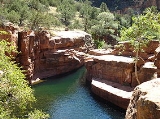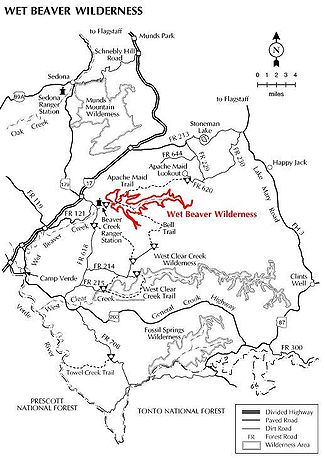
Wet Beaver Wilderness
Encyclopedia

National Wilderness Preservation System
The National Wilderness Preservation System of the United States protects federally managed land areas designated for preservation in their natural condition. It was established by the Wilderness Act upon the signature of President Lyndon B. Johnson on September 3, 1964...
located in the Coconino National Forest
Coconino National Forest
The Coconino National Forest is a 1.856-million acre United States National Forest located in northern Arizona in the vicinity of Flagstaff. Originally established in 1898 as the "San Francisco Mountains National Forest Reserve", the area was designated a U.S...
in the U.S. state
U.S. state
A U.S. state is any one of the 50 federated states of the United States of America that share sovereignty with the federal government. Because of this shared sovereignty, an American is a citizen both of the federal entity and of his or her state of domicile. Four states use the official title of...
of Arizona
Arizona
Arizona ; is a state located in the southwestern region of the United States. It is also part of the western United States and the mountain west. The capital and largest city is Phoenix...
.
Wet Beaver Creek is a perennial stream with one major tributary, Dry Beaver Creek. The confluence of the two is at McGuireville, Arizona. Beaver Creek flows past Montezuma Well
Montezuma Well
Montezuma Well , a detached unit of Montezuma Castle National Monument, is a natural limestone sinkhole near Rimrock, Arizona through which some of water flow each day through two underground springs. It is located northeast of Montezuma Castle. The well measures in at across and deep. The...
and Montezuma Castle
Montezuma Castle National Monument
Montezuma Castle National Monument, located near Camp Verde, Arizona, in the Southwestern United States, features well-preserved cliff-dwellings. They were built and used by the Pre-Columbian Sinagua people, northern cousins of the Hohokam, around 700 AD. Several Hopi clans trace their roots to...
before joining the Verde River
Verde River
The Verde River is the north and northwestern watershed of the Salt River–Verde River Watershed that co-join and enter the Gila River at Phoenix, Arizona, located in the U.S. state of Arizona...
near Camp Verde, Arizona
Camp Verde, Arizona
Camp Verde is a town in Yavapai County, Arizona, United States. According to 2006 Census Bureau estimates, the population of the town is 10,610....
.
Wildlife
The year-round waters in the Wet Beaver Wilderness attract large numbers of wildlife, including elkElk
The Elk is the large deer, also called Cervus canadensis or wapiti, of North America and eastern Asia.Elk may also refer to:Other antlered mammals:...
, deer
Deer
Deer are the ruminant mammals forming the family Cervidae. Species in the Cervidae family include white-tailed deer, elk, moose, red deer, reindeer, fallow deer, roe deer and chital. Male deer of all species and female reindeer grow and shed new antlers each year...
, bear
Bear
Bears are mammals of the family Ursidae. Bears are classified as caniforms, or doglike carnivorans, with the pinnipeds being their closest living relatives. Although there are only eight living species of bear, they are widespread, appearing in a wide variety of habitats throughout the Northern...
, mountain lion, and a variety of smaller mammals, reptiles, and birds.
Trails
The main trailhead to reach the Wet Beaver Wilderness, the 10.8 miles (17.4 km) Bell Trail, is located approximately 2 miles (3 km) east of the Sedona exit from I-17, near the Beaver Creek Ranger Station. The Bell Trail is a historic stock trail, which follows Beaver Creek upstream for about 3 miles (5 km) before climbing steeply up to the Mogollon RimMogollon Rim
The Mogollon Rim is a topographical and geological feature running across the U.S. state of Arizona. It extends approximately from northern Yavapai County eastward to near the border with New Mexico.-Description:...
at the southern edge of the Colorado Plateau
Colorado Plateau
The Colorado Plateau, also called the Colorado Plateau Province, is a physiographic region of the Intermontane Plateaus, roughly centered on the Four Corners region of the southwestern United States. The province covers an area of 337,000 km2 within western Colorado, northwestern New Mexico,...
. The only other trail in the Wilderness is the 9.5 miles (15.3 km) Apache Maid Trail.
Recreation
Common recreational activities in the Wet Beaver Wilderness include hiking, horseback riding, fishing (about 12 fishable miles), swimming, wildlife watching, and photography. The popular Beaver Creek campground, located outside the Wilderness at the creek crossing just below the ranger station, is operated by the US Forest Service and requires a fee.Overnight camping is prohibited by Forest Order between the parking area at the west end of the canyon, near the old Forest Service Ranger Station and the Campground, and continuing upstream (east) to a signed point approximately one-quarter mile upstream from where the Bell Trail (FT #13) crosses Wet Beaver Creek. This closure has been established to reduce the impact the area has received in recent years.
Recreation features
- Gravel, dirt and trail access
- Swimming
- Parking area with trailer spaces
- Tables
- Drinking water
- Restrooms
- Camping allowed
Fish species
- Rainbow TroutRainbow troutThe rainbow trout is a species of salmonid native to tributaries of the Pacific Ocean in Asia and North America. The steelhead is a sea run rainbow trout usually returning to freshwater to spawn after 2 to 3 years at sea. In other words, rainbow trout and steelhead trout are the same species....
- Brown TroutBrown troutThe brown trout and the sea trout are fish of the same species....
- Smallmouth BassSmallmouth bassThe smallmouth bass is a species of freshwater fish in the sunfish family of the order Perciformes. It is the type species of its genus...
- BullfrogBullfrogThe American bullfrog , often simply known as the bullfrog in Canada and the United States, is an aquatic frog, a member of the family Ranidae, or “true frogs”, native to much of North America. This is a frog of larger, permanent water bodies, swamps, ponds, and lakes, where it is usually found...
s - Yellow BassYellow bassThe yellow bass or barfish, Morone mississippiensis, is a freshwater fish native to the south and midwestern United States. Though sometimes confused with white bass or striped bass, it is distinguished by its yellow belly and the broken pattern in its lowermost stripes...
See also
- V-bar-V petroglyph siteV-bar-V petroglyph siteThe V-bar-V petroglyph site is the largest known petroglyph site in the Verde Valley of central Arizona, and one of the best-preserved. The rock art site consists of 1,032 petroglyphs in 13 panels. Acquired by the Coconino National Forest in 1994, the site is protected and kept open to the public...
, one-half mile west. - List of Arizona Wilderness Areas
- List of U.S. Wilderness Areas
- Wilderness ActWilderness ActThe Wilderness Act of 1964 was written by Howard Zahniser of The Wilderness Society. It created the legal definition of wilderness in the United States, and protected some 9 million acres of federal land. The result of a long effort to protect federal wilderness, the Wilderness Act was signed...
External links
- Wet Beaver Wilderness - Coconino National Forest
- Wet Beaver Wilderness - Wilderness.net
- Bell Trail, Wet Beaver Creek - ArizonaHikingTrails.com
- Beaver Creek Campground - Coconino National Forest
- Video of Wet Beaver Creek - Arizona Game & Fish

